headlights VOLVO XC90 TWIN ENGINE 2018 User Guide
[x] Cancel search | Manufacturer: VOLVO, Model Year: 2018, Model line: XC90 TWIN ENGINE, Model: VOLVO XC90 TWIN ENGINE 2018Pages: 686, PDF Size: 17 MB
Page 344 of 686

||DRIVER SUPPORT
342
WARNING
•
The "City Safety in crossing traffic" func-
tion is supplementary driver support
intended to improve driving safety – it
cannot handle all situations in all traffic,
weather and road conditions.
• Warnings and brake interventions due to
a collision risk with an oncoming vehicle
often come very late.
• Never wait for a collision warning or for
City Safety to intervene.
• City Safety is not a substitute for the driv-
er's attention and judgment. The driver is
always responsible for ensuring the vehi-
cle is driven in a safe manner, at the
appropriate speed, with an appropriate
distance to other vehicles, and in accord-
ance with current traffic rules and regula-
tions.
Related information
•
City Safety™ (p. 335) Limitations of City Safety in
crossing traffic
In certain situations, it may be difficult for City
Safety to help the driver avoid a collision with
crossing traffic. For example:
• on slippery roads when Electronic Stability
Control (ESC) is actively operating
• if an approaching vehicle is detected at a late
stage
• if the oncoming vehicle is partially obstructed
by another vehicle or object
• if the oncoming vehicle's headlights are off
• if the oncoming vehicle is moving erratically
and e.g. suddenly changes lanes at a late
stage.
NOTE The function uses the vehicle's camera unit,
which has some general limitations – see the
section "Camera unit limitations".
NOTE
The function uses the vehicle's radar unit,
which has some general limitations – see the
section "Radar unit limitations".
Related information
•
City Safety™ (p. 335)
Page 430 of 686
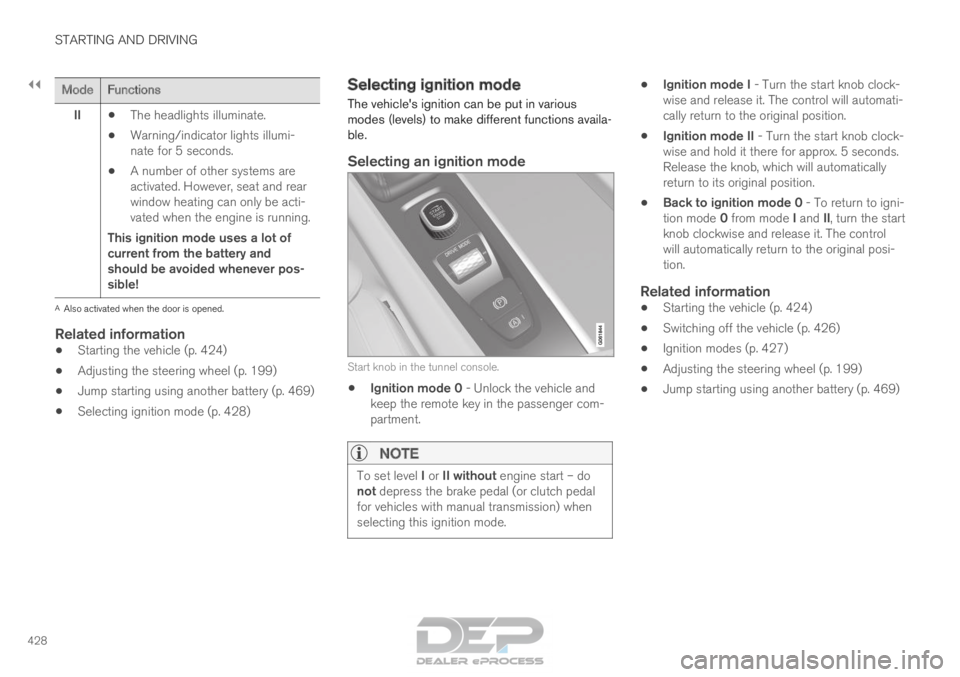
||STARTING AND DRIVING
428
Mode
Functions
II •The headlights illuminate.
• Warning/indicator lights illumi-
nate for 5 seconds.
• A number of other systems are
activated. However, seat and rear
window heating can only be acti-
vated when the engine is running.
This ignition mode uses a lot of
current from the battery and
should be avoided whenever pos-
sible! A
Also activated when the door is opened.
Related information
• Starting the vehicle (p. 424)
• Adjusting the steering wheel (p. 199)
• Jump starting using another battery (p. 469)
• Selecting ignition mode (p. 428) Selecting ignition mode
The vehicle's ignition can be put in various
modes (levels) to make different functions availa-
ble.
Selecting an ignition mode Start knob in the tunnel console.
•
Ignition mode 0 - Unlock the vehicle and
keep the remote key in the passenger com-
partment.
NOTE To set level I or II without engine start – do
not depress the brake pedal (or clutch pedal
for vehicles with manual transmission) when
selecting this ignition mode. •
Ignition mode I - Turn the start knob clock-
wise and release it. The control will automati-
cally return to the original position.
• Ignition mode II - Turn the start knob clock-
wise and hold it there for approx. 5 seconds.
Release the knob, which will automatically
return to its original position.
• Back to ignition mode 0 - To return to igni-
tion mode 0 from mode I and II, turn the start
knob clockwise and release it. The control
will automatically return to the original posi-
tion.
Related information
• Starting the vehicle (p. 424)
• Switching off the vehicle (p. 426)
• Ignition modes (p. 427)
• Adjusting the steering wheel (p. 199)
• Jump starting using another battery (p. 469)
Page 471 of 686
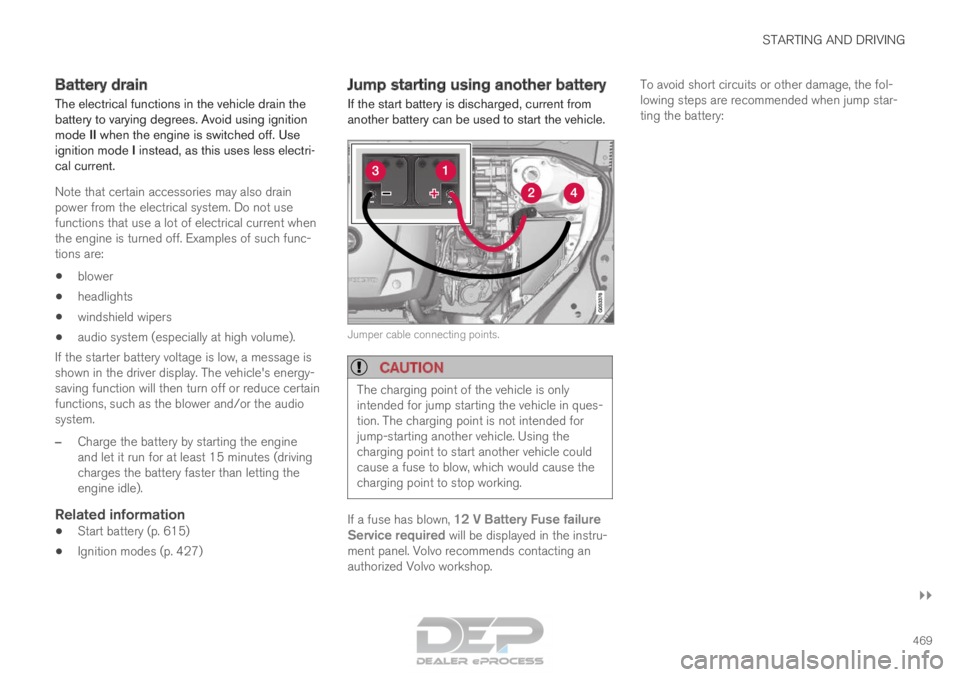
STARTING AND DRIVING
}}
469
Battery drain
The electrical functions in the vehicle drain the
battery to varying degrees. Avoid using ignition
mode II when the engine is switched off. Use
ignition mode I instead, as this uses less electri-
cal current.
Note that certain accessories may also drain
power from the electrical system. Do not use
functions that use a lot of electrical current when
the engine is turned off. Examples of such func-
tions are: • blower
• headlights
• windshield wipers
• audio system (especially at high volume).
If the starter battery voltage is low, a message is
shown in the driver display. The vehicle's energy-
saving function will then turn off or reduce certain
functions, such as the blower and/or the audio
system.
– Charge the battery by starting the engine
and let it run for at least 15 minutes (driving
charges the battery faster than letting the
engine idle).
Related information
• Start battery (p. 615)
• Ignition modes (p. 427) Jump starting using another battery
If the start battery is discharged, current from
another battery can be used to start the vehicle. Jumper cable connecting points.
CAUTION
The charging point of the vehicle is only
intended for jump starting the vehicle in ques-
tion. The charging point is not intended for
jump-starting another vehicle. Using the
charging point to start another vehicle could
cause a fuse to blow, which would cause the
charging point to stop working.
If a fuse has blown, 12 V Battery Fuse failure
Service required will be displayed in the instru-
ment panel. Volvo recommends contacting an
authorized Volvo workshop. To avoid short circuits or other damage, the fol-
lowing steps are recommended when jump star-
ting the battery:
Page 601 of 686
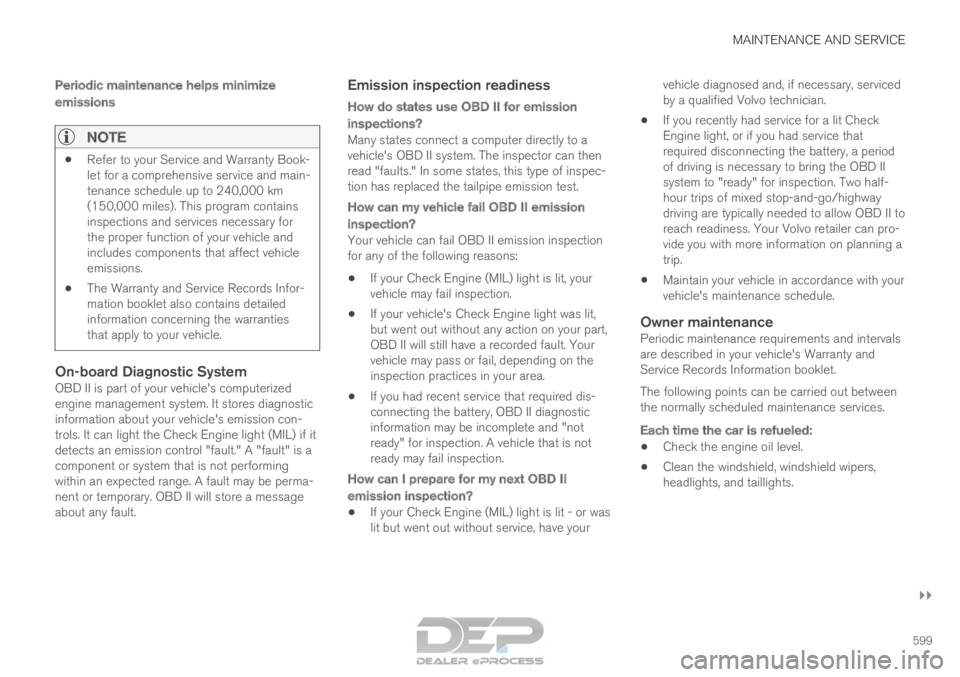
MAINTENANCE AND SERVICE
}}
599
Periodic maintenance helps minimize
emissions
NOTE •
Refer to your Service and Warranty Book-
let for a comprehensive service and main-
tenance schedule up to 240,000 km
(150,000 miles). This program contains
inspections and services necessary for
the proper function of your vehicle and
includes components that affect vehicle
emissions.
• The Warranty and Service Records Infor-
mation booklet also contains detailed
information concerning the warranties
that apply to your vehicle.
On-board Diagnostic SystemOBD II is part of your vehicle's computerized
engine management system. It stores diagnostic
information about your vehicle's emission con-
trols. It can light the Check Engine light (MIL) if it
detects an emission control "fault." A "fault" is a
component or system that is not performing
within an expected range. A fault may be perma-
nent or temporary. OBD II will store a message
about any fault.
Emission inspection readiness
How do states use OBD II for emission
inspections?
Many states connect a computer directly to a
vehicle's OBD II system. The inspector can then
read "faults." In some states, this type of inspec-
tion has replaced the tailpipe emission test.
How can my vehicle fail OBD II emission
inspection?
Your vehicle can fail OBD II emission inspection
for any of the following reasons:
• If your Check Engine (MIL) light is lit, your
vehicle may fail inspection.
• If your vehicle's Check Engine light was lit,
but went out without any action on your part,
OBD II will still have a recorded fault. Your
vehicle may pass or fail, depending on the
inspection practices in your area.
• If you had recent service that required dis-
connecting the battery, OBD II diagnostic
information may be incomplete and "not
ready" for inspection. A vehicle that is not
ready may fail inspection.
How can I prepare for my next
OBD II
emission inspection?
• If your Check Engine (MIL) light is lit - or was
lit but went out without service, have your vehicle diagnosed and, if necessary, serviced
by a qualified Volvo technician.
• If you recently had service for a lit Check
Engine light, or if you had service that
required disconnecting the battery, a period
of driving is necessary to bring the OBD II
system to "ready" for inspection. Two half-
hour trips of mixed stop-and-go/highway
driving are typically needed to allow OBD II to
reach readiness. Your Volvo retailer can pro-
vide you with more information on planning a
trip.
• Maintain your vehicle in accordance with your
vehicle's maintenance schedule.
Owner maintenancePeriodic maintenance requirements and intervals
are described in your vehicle's Warranty and
Service Records Information booklet.
The following points can be carried out between
the normally scheduled maintenance services.
Each time the car is refueled:
•Check the engine oil level.
• Clean the windshield, windshield wipers,
headlights, and taillights.
Page 615 of 686
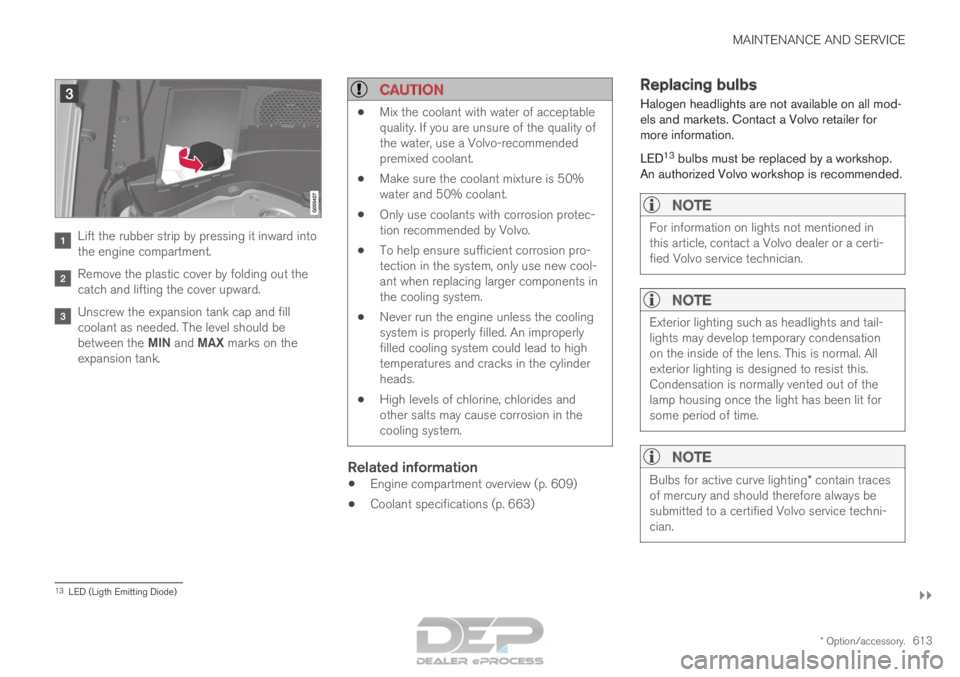
MAINTENANCE AND SERVICE
}}
* Option/accessory. 613Lift the rubber strip by pressing it inward into
the engine compartment.
Remove the plastic cover by folding out the
catch and lifting the cover upward.
Unscrew the expansion tank cap and fill
coolant as needed. The level should be
between the MIN and MAX marks on the
expansion tank.
CAUTION •
Mix the coolant with water of acceptable
quality. If you are unsure of the quality of
the water, use a Volvo-recommended
premixed coolant.
• Make sure the coolant mixture is 50%
water and 50% coolant.
• Only use coolants with corrosion protec-
tion recommended by Volvo.
• To help ensure sufficient corrosion pro-
tection in the system, only use new cool-
ant when replacing larger components in
the cooling system.
• Never run the engine unless the cooling
system is properly filled. An improperly
filled cooling system could lead to high
temperatures and cracks in the cylinder
heads.
• High levels of chlorine, chlorides and
other salts may cause corrosion in the
cooling system.
Related information
•Engine compartment overview (p. 609)
• Coolant specifications (p. 663) Replacing bulbs
Halogen headlights are not available on all mod-
els and markets. Contact a Volvo retailer for
more information.
LED 13
bulbs must be replaced by a workshop.
An authorized Volvo workshop is recommended.
NOTE For information on lights not mentioned in
this article, contact a Volvo dealer or a certi-
fied Volvo service technician.
NOTE
Exterior lighting such as headlights and tail-
lights may develop temporary condensation
on the inside of the lens. This is normal. All
exterior lighting is designed to resist this.
Condensation is normally vented out of the
lamp housing once the light has been lit for
some period of time.
NOTE
Bulbs for active curve lighting* contain traces
of mercury and should therefore always be
submitted to a certified Volvo service techni-
cian. 13
LED (Ligth Emitting Diode)
Page 616 of 686
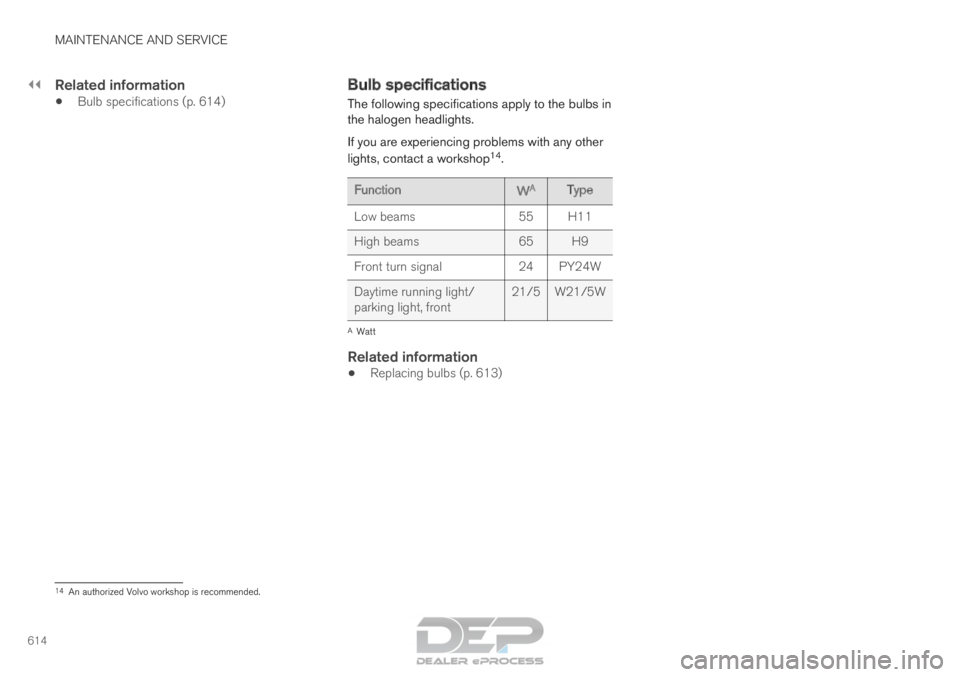
||MAINTENANCE AND SERVICE
614
Related information
•
Bulb specifications (p. 614) Bulb specifications
The following specifications apply to the bulbs in
the halogen headlights.
If you are experiencing problems with any other
lights, contact a workshop
14
. Function
WA
Type
Low beams
55 H11
High beams 65 H9
Front turn signal 24 PY24W
Daytime running light/
parking light, front 21/5 W21/5W A
Watt
Related information
• Replacing bulbs (p. 613) 14
An authorized Volvo workshop is recommended.
Page 642 of 686
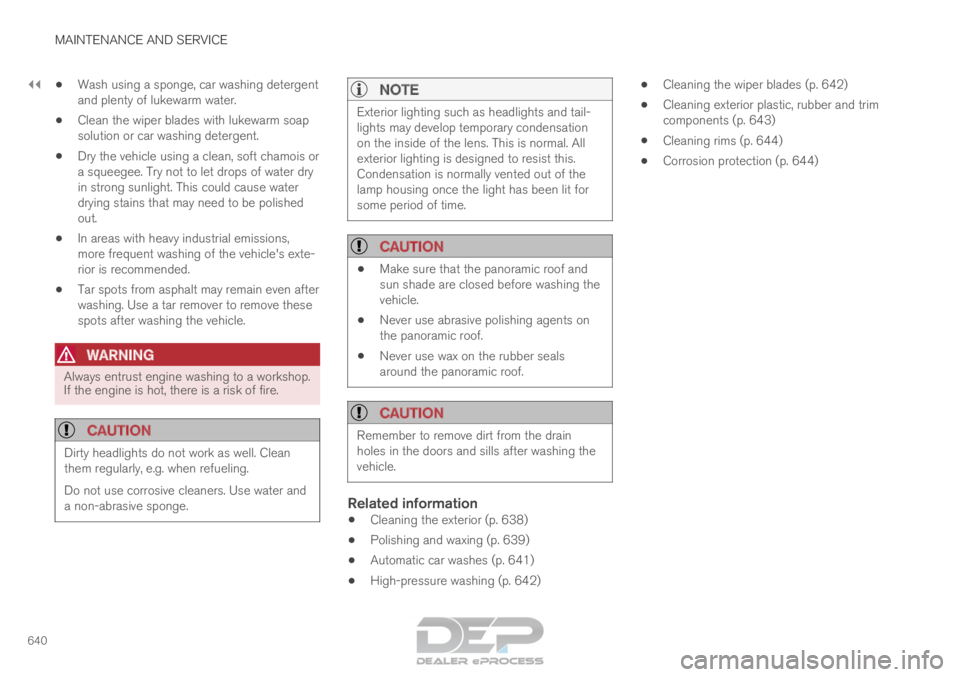
||MAINTENANCE AND SERVICE
640
•
Wash using a sponge, car washing detergent
and plenty of lukewarm water.
• Clean the wiper blades with lukewarm soap
solution or car washing detergent.
• Dry the vehicle using a clean, soft chamois or
a squeegee. Try not to let drops of water dry
in strong sunlight. This could cause water
drying stains that may need to be polished
out.
• In areas with heavy industrial emissions,
more frequent washing of the vehicle's exte-
rior is recommended.
• Tar spots from asphalt may remain even after
washing. Use a tar remover to remove these
spots after washing the vehicle.
WARNING Always entrust engine washing to a workshop.
If the engine is hot, there is a risk of fire.
CAUTION
Dirty headlights do not work as well. Clean
them regularly, e.g. when refueling.
Do not use corrosive cleaners. Use water and
a non-abrasive sponge.
NOTE Exterior lighting such as headlights and tail-
lights may develop temporary condensation
on the inside of the lens. This is normal. All
exterior lighting is designed to resist this.
Condensation is normally vented out of the
lamp housing once the light has been lit for
some period of time.
CAUTION
•
Make sure that the panoramic roof and
sun shade are closed before washing the
vehicle.
• Never use abrasive polishing agents on
the panoramic roof.
• Never use wax on the rubber seals
around the panoramic roof.
CAUTION Remember to remove dirt from the drain
holes in the doors and sills after washing the
vehicle.
Related information
•
Cleaning the exterior (p. 638)
• Polishing and waxing (p. 639)
• Automatic car washes (p. 641)
• High-pressure washing (p. 642) •
Cleaning the wiper blades (p. 642)
• Cleaning exterior plastic, rubber and trim
components (p. 643)
• Cleaning rims (p. 644)
• Corrosion protection (p. 644)
Page 652 of 686

||MAINTENANCE AND SERVICE
* Option/accessory.
650 The wiper blades will also move out of service
position if:
• The windshield wipers are turned on.
• The windshield washers are turned on.
• The rain sensor is activated.
• The vehicle begins moving.
CAUTION If the wiper arms in service position are raised
from the windshield, they must be folded back
against the windscreen before activating wip-
ing, washing or rain sensor as well as before
departure. This is to prevent scratching the
paint on the hood.
Related information
•
Using the rain sensor (p. 177)
• Using the windshield and headlight washers
(p. 179)
• Using automatic rear window wiping when
backing up (p. 181)
• Heated windshield washer nozzles* (p. 177)
• Using the rain sensor's memory function
(p. 178)
• Using the rear window wiper/washer
(p. 180)
• Filling washer fluid (p. 650)
• Replacing windshield wiper blades (p. 648) •
Changing rear window wipers (p. 647)
• Using the windshield wipers (p. 176) Filling washer fluid
Washer fluid is used to keep the headlights,
windshield and rear window clean. Washer fluid
containing anti-freeze should be used in very
cold weather (below-freezing temperatures). Fill washer fluid into the reservoir with the blue
cover. The reservoir is used for the windshield
washer, tailgate window washer and headlight
washer*
NOTE
When there is approximately 1 liter (1 qt) of
washer fluid remaining, the message
Washer
fluid
Level low, refill and the symbol
will be displayed in the instrument panel.
Page 671 of 686
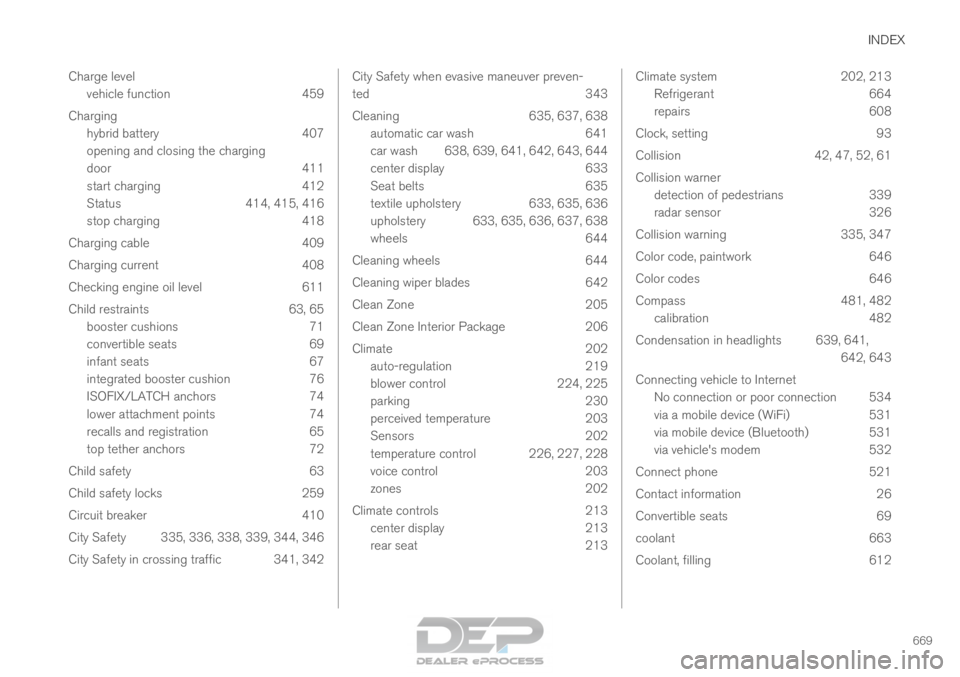
INDEX
669
Charge level
vehicle function 459
Charging hybrid battery 407
opening and closing the charging
door 411
start charging 412
Status 414, 415, 416
stop charging 418
Charging cable 409
Charging current 408
Checking engine oil level 611
Child restraints 63, 65 booster cushions 71
convertible seats 69
infant seats 67
integrated booster cushion 76
ISOFIX/LATCH anchors 74
lower attachment points 74
recalls and registration 65
top tether anchors 72
Child safety 63
Child safety locks 259
Circuit breaker 410
City Safety 335, 336, 338, 339, 344, 346
City Safety in crossing traffic 341, 342 City Safety when evasive maneuver preven-
ted
343
Cleaning
635, 637, 638
automatic car wash 641
car wash 638, 639, 641, 642, 643, 644
center display 633
Seat belts 635
textile upholstery 633, 635, 636
upholstery 633, 635, 636, 637, 638
wheels 644
Cleaning wheels 644
Cleaning wiper blades 642
Clean Zone 205
Clean Zone Interior Package 206
Climate 202
auto-regulation 219
blower control 224, 225
parking 230
perceived temperature 203
Sensors 202
temperature control 226, 227, 228
voice control 203
zones 202
Climate controls 213
center display 213
rear seat 213 Climate system
202, 213
Refrigerant 664
repairs 608
Clock, setting 93
Collision 42, 47, 52, 61
Collision warner detection of pedestrians 339
radar sensor 326
Collision warning 335, 347
Color code, paintwork 646
Color codes 646
Compass 481, 482 calibration 482
Condensation in headlights 639, 641, 642, 643
Connecting vehicle to Internet No connection or poor connection 534
via a mobile device (WiFi) 531
via mobile device (Bluetooth) 531
via vehicle's modem 532
Connect phone 521
Contact information 26
Convertible seats 69
coolant 663
Coolant, filling 612
Page 676 of 686
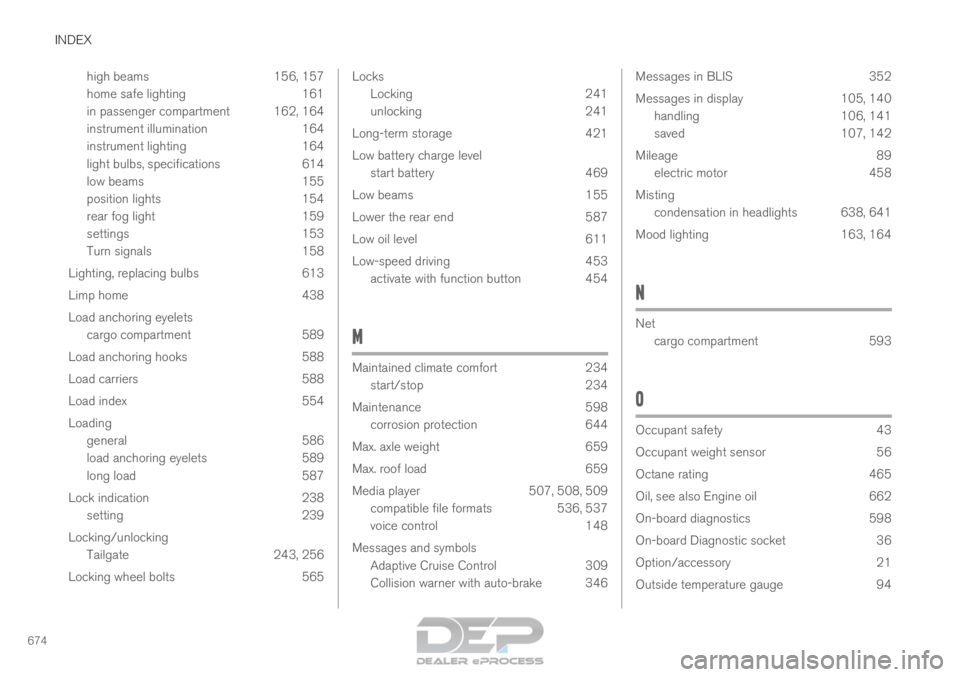
INDEX
674high beams 156, 157
home safe lighting 161
in passenger compartment 162, 164
instrument illumination 164
instrument lighting 164
light bulbs, specifications 614
low beams 155
position lights 154
rear fog light 159
settings 153
Turn signals 158
Lighting, replacing bulbs 613
Limp home 438
Load anchoring eyelets cargo compartment 589
Load anchoring hooks 588
Load carriers 588
Load index 554
Loading general 586
load anchoring eyelets 589
long load 587
Lock indication 238 setting 239
Locking/unlocking Tailgate 243, 256
Locking wheel bolts 565 Locks
Locking
241
unlocking 241
Long-term storage 421
Low battery charge level start battery 469
Low beams 155
Lower the rear end 587
Low oil level 611
Low-speed driving 453 activate with function button 454
M Maintained climate comfort
234
start/stop
234
Maintenance 598
corrosion protection 644
Max. axle weight 659
Max. roof load 659
Media player 507, 508, 509
compatible file formats 536, 537
voice control 148
Messages and symbols Adaptive Cruise Control 309
Collision warner with auto-brake 346 Messages in BLIS
352
Messages in display
105, 140
handling 106, 141
saved 107, 142
Mileage 89
electric motor 458
Misting condensation in headlights 638, 641
Mood lighting 163, 164
N Net
cargo compartment
593
O Occupant safety
43
Occupant weight sensor
56
Octane rating 465
Oil, see also Engine oil 662
On-board diagnostics 598
On-board Diagnostic socket 36
Option/accessory 21
Outside temperature gauge 94